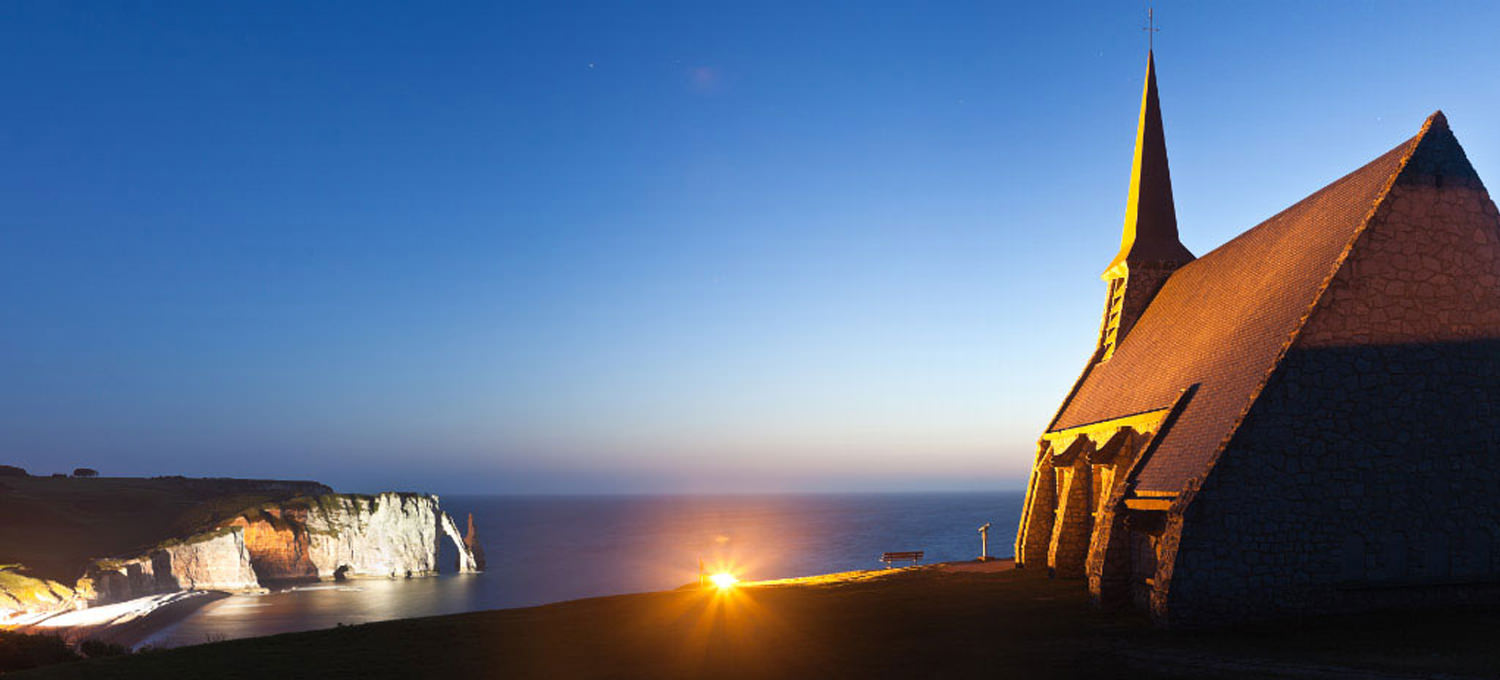What is a perfect weekend? It could be like an autumn weekend in Etretat with your loved one: a pretty seaside resort, the sea, the cliffs, the quaint little village, a blue sky... That's it, what more could you ask for?
In Etretat, you can ask for more: the sunset over the sea to top the weekend off! The Amont cliff offers a perfect view over the Aval cliff and its needle and arch, and one of the most beautiful sunsets in the world.
Beautiful views, in my opinion, are to be earned. Of course we could have taken the car to get to the plateau, which is about 80 metres (262 ft.) high above the sea. But if you are not in a hurry, it's better to take a nice walk up the Rue Gerbeau: after a short walk, the view is all the more beautiful!
'We could have taken the car there, couldn't we?' Clara whispered; she apparently does not share my idea of views-to-be-earned.
'It's not very far anymore, and, with all those pretty houses, the walk is pleasant, don't you think?'
Beautiful houses, there are plenty in Etretat!
This humble fishing village became a fashionable seaside resort in the mid-19th century, just like other Norman beaches including Dieppe and Varengeville-sur-mer. It is the writer, Alphonse Karr, who was the first to make Etretat known. From that moment, the village would remain linked to artists, writers, painters and musicians.
There are many famous admirers who fell in love with Etretat for one single summer or a whole life: Guy de Maupassant, Maurice Leblanc, Jacques-Émile Blanche, Johan Barthold Jongkind, Georges Simenon, Eugène Boudin... But also Corot, Courbet, Delacroix, Matisse, Bizet, or, more recently, Benoît Duteurtre and Olivier Adam...
Etretat has kept many reminders of the stays of the entire 19th century artistic scene. Like the Villa Orphée, which was bought by the composer Offenbach with the copyrights of Orpheus in the Underworld! Like the Clos Lupin, Maurice Leblanc's house, whose hero, Arsène Lupin, had some of his adventures in Etretat, and which has now become a mystery museum. Like the Villa Haut-Mesnil, where Georges Simenon located one of Inspector Maigret's cases...
How time flies, especially in this setting that seems to come straight out of a novel or opera... Anyway we had time to stroll in the little streets in the village and admire the "Halles", old covered market, in the town centre, with its exposed timber framework that looks like a ship's hull, and also the Hotel de la Salamandre with its wood carvings and small stained-glass windows...
And of course, we climbed up the Aval cliff, one of the most famous views in Normandy: the needle and the arch of Etretat.
Up there, the panoramic view is worth a look: you can see the golf of Etretat and hares running in the grass on the right, the village below, the needle in front, the small arch of the Amont cliff to the north and the grand Manneporte arch to the south…
The place draws you into reveries: it is in this "chalk cathedral" that Arsène Lupin discovered the treasure of the kings of France, piles of gold, jewels and gemstones. Was he inspired by this small natural cave, which is called the "chambre des demoiselles" (ladies' room) and looks like a chalk safe?
As for us, the only treasures we have seen were the nests that the seagulls guard jealously. And be careful if you dare get close to their eggs!
'We have to pick up the pace, Clara...'
'But we are on weekend, we are already rushing about all week...'
'I know, but the sun is about to set. If we want to enjoy the sunset from the chapel, we must hurry up...'
Finally, here is the top of the cliff. And, just as I thought, walking there makes the spectacle even more amazing!
'Look, see', sighed Clara, 'there was a car park in fact. That's exactly what I thought; we could have taken the car...'
Standing in the green grass, the chapel Notre-Dame de la Garde, dedicated to the protection of sailors, watches over the bay. As the fishermen have long been gone from Etretat, we can assume it is now dedicated to the lovers who come here, on the benches facing the Aval cliff, to watch the sunset.
Every minute, the scene changes as the sun goes down. Thousands of views of Etretat pass before our eyes, with dozens of seagulls flying in circles over the village, with the low tide that reveals the "grotte du trou à l'homme" (manhole), with the shadows of the arch and needle getting longer, with the horizon tinged with pink and orange...
Always fascinated by the effect of light on landscapes, Claude Monet painted more than 80 canvases here...
And this is Etretat! During one sunset, thousands of Monets offered to lovers!






